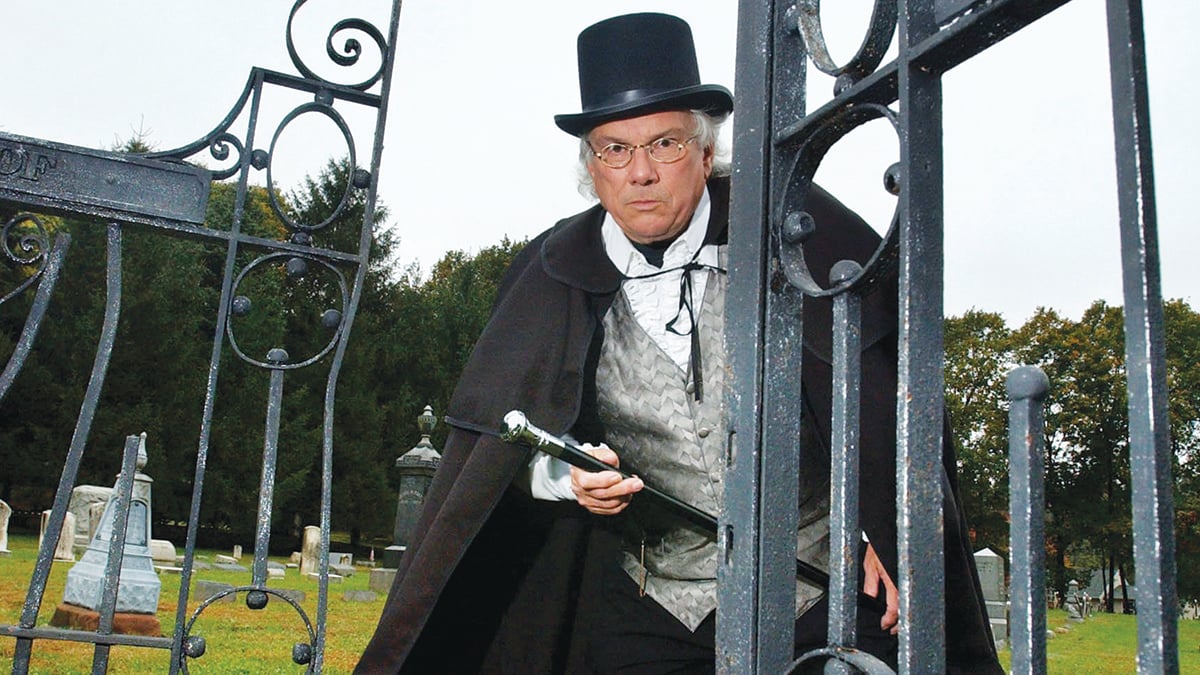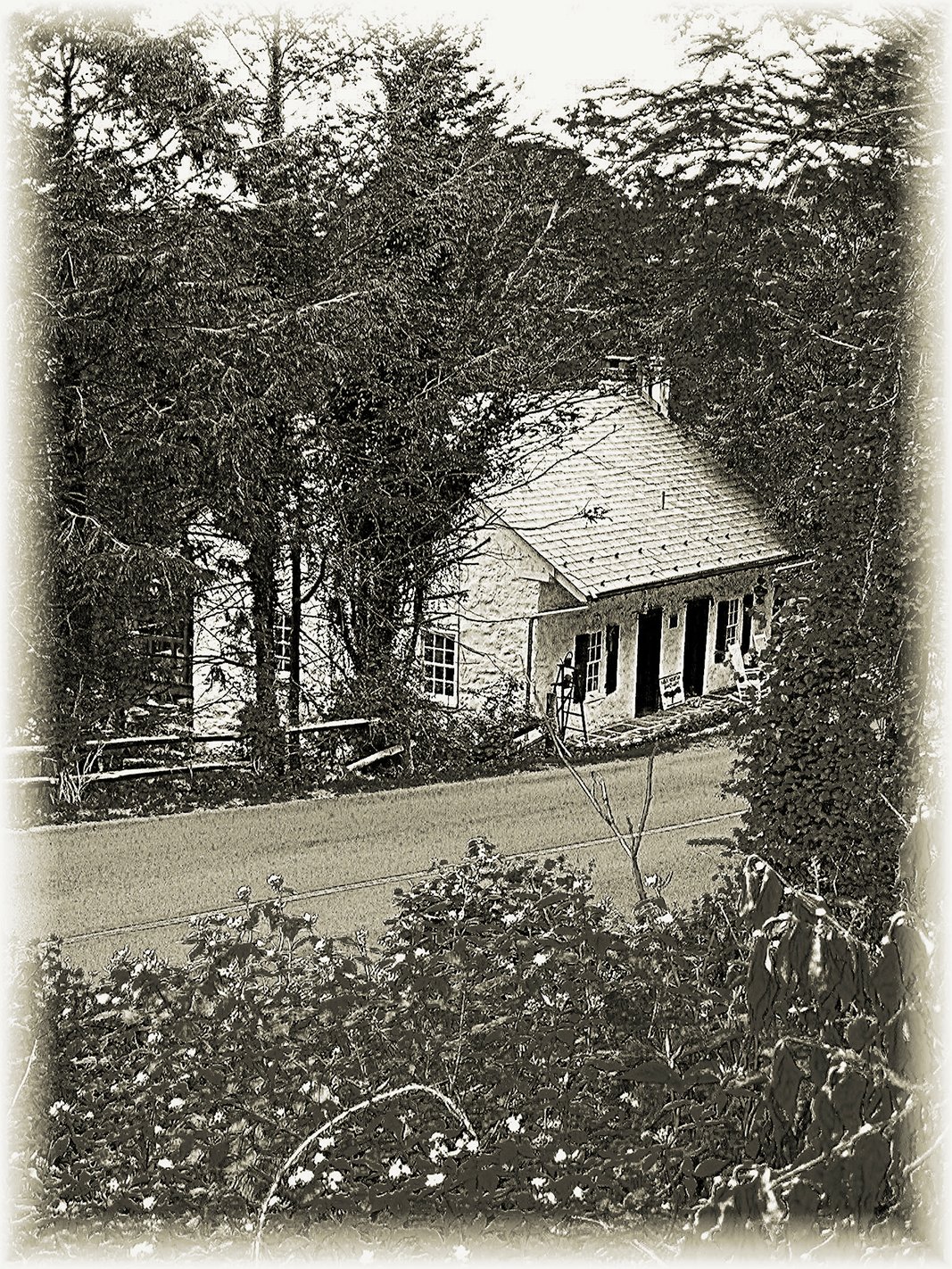
For Charlie Adams, a lifetime fascination with ghosts was born in the bowels of a US Navy aircraft carrier somewhere on the North Atlantic Ocean more than half a century ago.
Adams, then a young sailor of 20, was on midnight watch aboard the huge ship which had been rebuilt following a kamikaze attack during World War II. That attack claimed lives of both the attackers and Navy personnel on board.
“I heard these muffled sounds of yelling and running on the deck,” he says. “I radioed up and asked what was happening. The response was: ‘Nothing’ and I was told to resume my watch.”
Adams was to learn that he was standing watch at precisely the spot where the kamikaze hit and sailors died. Some “old salts,” he says, told him his eerie experience had been shared by others in the 20-plus years since the war ended.
About two weeks after that event, the ship docked at its Portsmouth, England, port of call. He made his way to the house of legendary author Charles Dickens, encountering a curator who was thrilled a young sailor would take such interest.
Liking the Dickens
The curator explained that Dickens created his stories out of old English superstitions and folklore. Key among those is the iconic A Christmas Carol. Dickens, who self-published, would venture out to tell the stories as he marketed his books.
“I thought: ‘That’s a pretty good gig,’” says Adams. “That was the spark of everything for me, my inspiration.”
Following discharge, he returned to Berks and began a long career in local print journalism and radio. He spent eight years at the former Berks County Record and segued into a long and notable role as a broadcaster at WEEU.
Around 1978, he wrote an article for the Record with a stunning 74-point headline reading: “Is Berks County Haunted?” The story never really answered the question, but it paved the way for Adams to become recognized as the area’s most prolific ghost story writer by asking readers if they knew of any “spirited” places.
The tips poured in, filling first a shoe box, and ultimately, a filing cabinet.
Adams went on the hunt, doing research at local libraries as well as the Historical Society of Berks County and other institutions. He also interviewed a number of the tipsters.
The result, in 1982, was his first book aptly titled Ghost Stories of Berks County. It contained about 25 stories and was 125 pages. Adams, writing as Charles J. Adams III, and his wife, Theresa, emptied their savings account and self-published the book.
Putting into practice the Dickensian example, the couple visited places like the Pagoda gift shop and local bookstores and would “drop off a dozen here or there.” Their guerilla marketing worked; they began to get requests for a few dozen more at some retailers and even cases at others. Volumes two and three would soon follow.
Radio days and TV times
By that time, Adams was on staff at WEEU and found a business partner – and life-long friend – in ad salesman Dave Seibold. The result has been the self-publication of 35 books, including 18 editions of ghost stories of other areas such as New York City. He was even approached by a well-known publisher who took a liking to the Berks ghost trilogy.
“He wanted to ‘spice things up’,” Adams recalls, “and I had no desire to do that.”
Still his celebrity status as an author of spirits grew. He began – and continues – to conduct ghost tours, particularly in the autumn leading to Halloween. By his estimate, he’s done some 250, including ones in Ireland, Scotland, Wales and England.
He’s gained some broader fame through appearances on television shows dedicated to the paranormal, including Ghost Hunters and Ghost Adventures. Though Adams notes the ego satisfaction derived from these stints, he also is bothered by the contrived showmanship he’s witnessed. The “bravery” of the hosts can come into question.
A case in point: during one taping at the supposedly haunted cell of gangster Al Capone in the Eastern State Penitentiary in Philadelphia, Adams, the host and the crew heard an inexplicable knocking sound. That sound was realistically impossible due to the foot-plus-thick stone walls. He recalls the host turning white and wanting to get out ASAP. Another interesting point about this site: Adams says the alleged ghost is not Capone, but rather that of Jimmy Clark, one of the seven men Capone ordered killed in the infamous 1929 St. Valentine’s Day Massacre. Clark, it is said, haunted Capone in the cell.
Spirits nearby?
While the old penitentiary has become a draw for paranormal aficionados, Adams notes several sites in Berks reputed to be haunted. These include focal points of some of his tours.
Vicinity of Union Canal Lock No. 49 at Gring’s Mill on the trail, Bern Township.
It was in August 1875 that a distraught pregnant Reading woman, Louisa Bissinger, drown herself and her three children in apparent response to a philandering husband and vengeful mother-in-law. Bissinger had her children help fill a basket with rocks that she tied to her waist. She then grabbed the children and jumped in the canal. There have been reported sightings of the children happily gathering the stones as their mother watched, but the images vanish as trail users draw closer. Some report hearing the cries of children. Others have reported a strong sense of doom along the path.

Hawk Mountain and the Appalachian Trail in northern Berks.
This area, known as America’s First Frontier, is steeped in history and legend, some of it horribly violent. Adams refers to “layers” of spirit activity in the area. During the French and Indian War, several settler families were massacred by Native Americans. Among those recorded was the 1757 killing of the Hochstetler family. A young son, Jacob, escaped and lived to tell the story. A century later, a tavern keeper owned a building said to have stood on the same spot as the Hochstetler home. Matthias Schaumboch, who operated the tavern from 1850 to 1889, reputedly confessed to murdering more than a dozen “guests” who stopped by over the years. The documentation of this is sketchy, but his ghost is said to still abide in the area. In the years following, it is said that two mountain men – hermits – lived and died under mysterious circumstances and that their spirits roam Hawk Mountain and the trail.
“Native American legend has it that the mountain was enchanted by the spirits of their ancestors,” says Adams of the first people of northern Berks. He advises, as he does with all allegedly haunted areas, to not visit expecting to witness apparitions or activity, but to keep an open mind.
Skyline Drive above the City of Reading.
Adams does not believe either the Pagoda or the William Penn Fire Tower, the two icons of Mount Penn, to be haunted. However, he cites two double murder-suicides in the 1920s and 1930s off the roadway as sparks for paranormal activity. One of those, the result of a lover’s quarrel, occurred near Drenkel Field. During and just after the Works Progress Administration Depression-era construction of the stone wall along the drive, reports entered into the WPA records noted appearances of a young couple standing in the middle of the road. The misty figures disappeared as they were approached.
Centre Park Historic District.
Both Sternbergh mansions on Centre Avenue, Overlook near Greenwich Street and Stirling just north of Robeson Street, are reputedly haunted, says Adams. Overlook, built in the 1860s, was the home of steel magnate James Hervey Sternbergh’s first wife and older children. Widowed and remarried, he built Stirling in 1892 for his second wife and younger set of children, including Gertrude Sternbergh, a renowned patron of the arts, who resided there from
birth to her death at age 96 in 1996. Overlook activity includes occasional loud footsteps on stairways, unexplained cold spots in rooms and a side porch with a decided sense of unease.
At Stirling, there have been reports of luggage falling down steps from an empty and long-abandoned storage room and sounds of a piano playing with no one nearby. “It’s long been rumored that Gertrude is on site,” says Adams. Also, apparently lingering outdoors is one of her relatives, perhaps her dad. Adams cites a wedding photograph taken in the yard some years ago, when developed showed “a guy standing in back of the wedding party, a mysterious figure in a top hat.” No one recognized the man whose image was slightly translucent. Adams has seen the photo but is not in possession of it as the family wants the experience to remain private.
Red Cross Building, Centre Avenue and Oley Street.
Reports by employees of sounds of people playing pool in the pool room. However, the use of the room changed decades ago; it’s a staff conference room. There are also stories of a girl running up and down the fire escape. Another more recent sighting is that of an employee who never returned from a lunch break, the victim of deadly domestic violence. Employees, not knowing her fate, reported seeing glimpses of her in the office in the days she was considered missing.
Hendel House, Centre Avenue and Douglass Street.
Visitors have reportedly seen the image of a young boy laughing as he sprints up the staircase to the second floor. According to Adams, word is the little boy died playing on those steps.
Charles Evans Cemetery, City of Reading.
Visitors have, he says, on occasion have felt “uncomfortable,” but he’s not convinced of ghostly appearances despite the legendary souls resting there, among them Louisa Bissinger and her doomed children. In the same plot lay her philandering husband and his second wife.
Wertz’s Red Bridge, Spring Township, linking to the Gring’s Mill Recreation Area.
Adams says there are several spirits there and all but one is a cow. The other is that of a long-ago toll keeper found dead in his shelter.
Beidler House, the circa 1783 property located in Robeson Township near the Allegheny Aqueduct.
Builder Jacob Beidler is said to “look over” his old farm. Also, the ghosts of a little boy and little girl, supposedly in bed, reportedly linger on the stairs curious to see what the adults are doing downstairs. “When I walk people through there, I ask them to ‘feel’ the surroundings,” Adams says.
FirstEnergy Stadium.
Word is that the scoreboard and other electronic signs flickered and fluttered after a devoted fan’s ashes were surreptiously – and illegally – dumped in the outfield at the deceased’s wishes. This is one of the tales Adams has shared during an onsite ghost story event.
All of Route 61 from the southern terminus at Greenwich Street in Reading to the northern terminus in Centralia.
“You can definitely call this a haunted highway,” Adams says. “It parallels the river and the old canal and ghostly tales abound in Leesport, Shoemakersville, Hamburg, Port Clinton and Schuylkill Haven. And, of course, Centralia, its buildings gone due to the underground coal fire, is the ultimate ghost town.”
Meanwhile, at home...
While readers may choose to visit these spirited locales and others, there may be activity close to home.
Adams experienced that when his now-grown daughter, Emily, was just six. She told him about a man in her closet named Izzy. Alarmed as any parent would be, Adams checked and found nothing. Emily’s window overlooked what was the Reiff Farm which, he learned, was owned long ago by one Israel Reiff.
“Hence, Izzy,” he says of that closet companion.
His advice to folks who believe there may be spirits afoot in their homes: be aware of the sudden abrupt pulses of heat or cold, a flash or absence of light, normal things that may go bump in the night – house noises.
“Be rational, see what these things could be attributed to,” he says.
Adams sees the analogy of spirits and their intents to an illuminated light bulb. The energy that fuels it is good – unless one removes the bulb, sticks a wet finger into a socket and is electrocuted.
“I don’t believe in demons,” he says. “There aren’t bad or good spirits, just the spirits’ energy. In the words of a great writer, I ain’t afraid of no ghosts.”

















